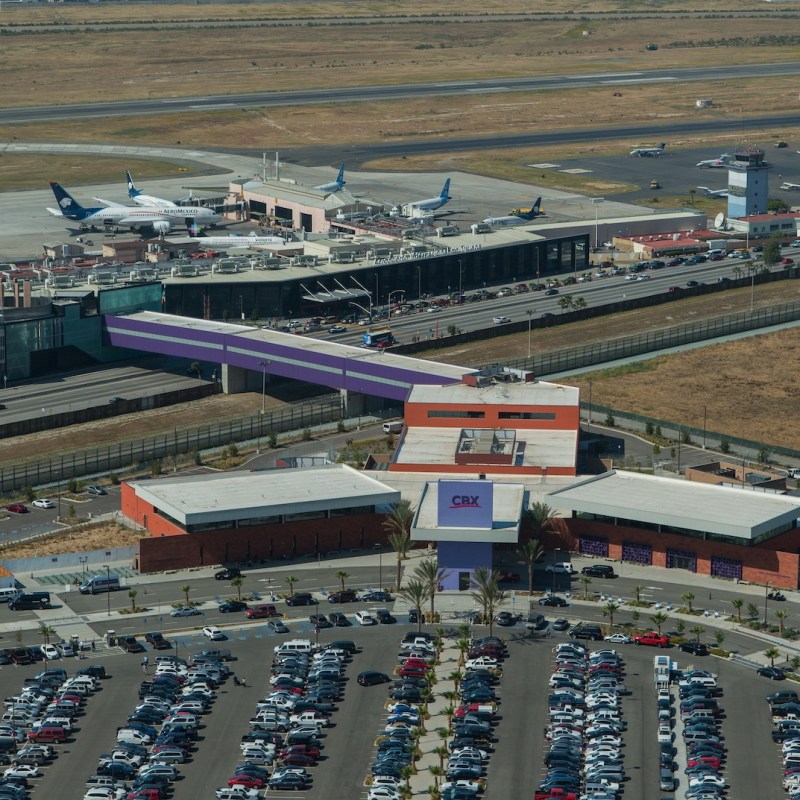
For passengers flying from southern California airports to destinations in Mexico, there is another option you may not have considered. Cross Border Xpress (CBX) offers a cheaper and oftentimes faster way to fly to Mexico. The facility is located in the Otay Mesa region of San Diego, California, and provides a crossing directly into Tijuana International Airport in Mexico.
Videos by TravelAwaits
My introduction to CBX actually pre-dates its existence. When visiting Cancún in 2012, we met someone who suggested that next time we visit Cancún, we should cross the border at Otay Mesa and fly out of Tijuana Airport instead of LAX. It would be much cheaper and more direct.
Later, after CBX was built, a co-worker told me that next time we visit Mexico, we should use CBX and fly out of Tijuana Airport. Recently, I got the opportunity to do just that for a flight to Puerto Vallarta, Mexico.
I was hosted on this trip to Puerto Vallarta by Cross Border Xpress (CBX) and the Puerto Vallarta Tourism Board. All opinions are my own.

What Is Cross Border Xpress (CBX)?
Cross Border Xpress (CBX) is a terminal located right on the U.S.-Mexico border. The centerpiece of CBX is a 390-foot-long enclosed pedestrian skybridge that crosses the border, allowing passengers to access the Tijuana International Airport (TIJ) from Otay Mesa, and vice versa.
“From its conception, CBX has sought to change the way people travel between southern California and Mexico by offering a faster, more convenient and efficient way to cross one of the busiest borders in the world,” says Jorge Goytortúa, CEO of Cross Border Xpress (CBX).
CBX is a joint effort between the U.S. and Mexico. The facility makes Tijuana Airport a binational airport — the only true such airport with facilities on both sides of the border — and the first to connect a U.S. facility directly to a foreign airport terminal. (Though EuroAirport Basel Mulhouse Freiburg is operated by both France and Switzerland, it is entirely on the French side of the border.)

History Of CBX
Discussions about a possible cross-border terminal started way back in the 1960s. They began with a proposal brought up by Mexico’s then-Minister of Public Works, Gilberto Valenzuela Ezquerro, who was tasked with modernizing the country’s transportation system and airports.
For the next 20 years, plans sat pretty much dormant until 1987. Between 1987 and 2006, plans and negotiations involving numerous people and organizations were conceived, abandoned, refloated, failed, revived, canceled, and reborn.
Eventually, the proposed cross-border terminal was incorporated into the development of the Tijuana Airport. That led to the creation of private investment group Otay-Tijuana Venture LLC, which developed the CBX and currently operates it. Construction on the facility was underway in 2013. Cross Border Xpress opened on December 9, 2015.
CBX’s 50-year journey begs the question: Why not expand San Diego Airport instead of building a whole new airport or airport terminal? The simple answer is it’s not possible. San Diego Airport only has one runway and it is relatively short, which restricts the size of planes that can land there, and, by extension, the destinations that can be reached. But because there are hills and skyscrapers on one end, and San Diego Bay framing it on two other sides, there’s simply no room to build out more. The CBX solution was basically to build a bridge over the border wall into Tijuana Airport.

Expansion Of The Facility
Since its opening, CBX has experienced massive growth, welcoming nearly 3 million passengers in 2021 alone. When CBX first began operations, it had only four customs booths. Earlier this year, 12 more booths were added for a total of 16. This created highly reduced wait times for travelers passing through customs.
Further renovation and expansion plans for CBX include projects on both sides of the border. On the Otay Mesa (San Diego) side, CBX will add a parking structure, gas station, restaurants, retail shops, car rental facilities, and hotel rooms. Roads coming into and leaving CBX will be redesigned to improve access.
On the Tijuana Airport side, Grupo Aeroportuario del Pacifico invested $100 million in an expansion project. The new multi-level passenger processing facility, which opened last month, doubles the size of the airport, and includes a new baggage claim area. Standardizing the immigrations and customs process will speed up the procedure for travelers crossing the border via CBX.
In addition to the 35 Mexican destinations already served by Tijuana Airport, the expansion will allow airlines to provide access to a variety of new destinations in Central America, South America, Europe, and Asia. (Flights to Beijing and Shanghai were halted during COVID-19, but are due to resume.)

My Experience Using CBX
Our group used CBX to fly from Tijuana Airport to Puerto Vallarta. Using CBX to fly out of Tijuana Airport meant our flight to Puerto Vallarta was now a domestic flight instead of an international one. CBX says this saves travelers 30–50 percent versus flying from other southern California airports. And it meant we would not have to go through immigration in Puerto Vallarta.
We met up just inside the CBX terminal at around 3:30 a.m. We already had our airline and CBX tickets so we were able to skip the ticket counters.
We learned you can only use CBX if you have a valid boarding pass and are flying out of Tijuana Airport within 24 hours. On the other side, ticketed passengers arriving at Tijuana Airport who have not left the baggage claim area, and are still within 2 hours of their flight landing, can use CBX to cross into the U.S. You cannot use CBX as a pedestrian crossing the border into Tijuana or into the U.S.
Required Documentation
For U.S. citizens like our group (and for non-Mexican citizens), required documents include a valid passport, FMM Form (Forma Migratoria Múltiple), Migratory Rights payment (necessary only if staying in Mexico longer than 7 days), boarding pass, health questionnaire, and a valid CBX ticket. (CBX ticket prices vary according to season.)
FMM Form
You can fill out the FMM Form online at the CBX site but it may be a bit complicated. It is easier to fill out the form at the computer terminal near the ticket counter on the U.S. side. That is what we did. However, if you are traveling during busy times, fill out the form online in advance.
Other Documentation
Having your boarding pass and CBX ticket readily accessible on your smartphone makes navigating through CBX easier and touchless. You can still use paper copies, but having these documents on your smartphone saves time. Downloading the CBX app makes it even easier. That said, having a printed copy as a backup is a good idea. Bring a pen, too.
We also learned that once you’ve passed the first checkpoint inside CBX, you cannot leave the facility. If you do, you cannot re-enter.
Pro Tip: Note this well. There are accounts of travelers who had to leave CBX for whatever reason, having to make their way back to the U.S. on their own, and returning to CBX several hours later (and several dollars lighter).

Crossing Into The Tijuana Airport
With all of our documents in order, we were ready to cross from San Diego to the Tijuana Airport. We breezed through the first checkpoint and arrived at a completely empty skybridge. After crossing the skybridge into Mexico, we breezed through the Mexican immigration checkpoint as well. Minutes later, we arrived at the boarding gate. There were plenty of restaurants and shops at the terminal, many of them open even at 4 a.m.
Pro Tip: We had a 5 a.m. flight so CBX was very quiet. However, if you are flying during peak travel times, factor in more time than you think you’ll need, especially if you plan to park at the airport.

Returning To The U.S.
Returning from Puerto Vallarta, we reversed the process, crossing from Tijuana to San Diego. To use CBX to enter the U.S., a valid passport, boarding pass from your arrival flight, and CBX ticket are required. You’ll need them to access the bridge. If you are not a U.S. citizen and wish to travel more than 25 miles from the border, or stay longer than 30 days inside the U.S., you’re required to pre-pay and fill out form I-94 before you can cross the skybridge.
After passing through baggage claim, we walked to and across the skybridge. Customs booths awaited downstairs.
Pro Tip: Global Entry lines are very helpful here. Two other flights arrived at Tijuana Airport at the same time as ours. The separate Global Entry line was empty. As we neared the customs booth, two families walked through the Global Entry line and, of course, were waved right up to the next available agent. Though we didn’t have Global Entry, our wait to pass through customs was less than an hour. This was around 9 p.m. on a Thursday.
Getting To CBX
Driving is the most direct way to get to CBX, which is how I arrived. But I would recommend using one of many public transportation alternatives.
The CBX Shuttle operated by Damaris Express has connections from over two dozen points in southern, central, and northern California. Limousine Express extends access to Nevada, Arizona, and Texas. (I’d suggest calling them for details).
Rideshare company Lyft is another option. (Sorry, Uber users. Uber is no longer available at CBX.) Shuttles or taxis will take you to CBX from Amtrak or San Diego Trolley stations, or from San Diego Airport. You can also park at the San Ysidro border crossing and take a taxi or Lyft over to CBX. You can also have a friend drop you off, or use some combination of the above methods.
Parking At CBX
As with many airports, parking at CBX can be difficult depending on the day and time of your arrival. Because we had an early flight, I had no problem parking in one of the available paid parking lots. There is free parking on the nearby streets, but you’ll risk being blocked in by other cars parking inches from your bumper.
Otay Mesa Parking (Delta Truck Parking) is nearby and a bit cheaper. They have a shuttle that runs to CBX.
Parking Pro Tips
You have the option to pre-pay for paid-lot parking on the CBX website or at one of the kiosks inside CBX. As convenient as that is, I’d recommend forgoing that option. Any number of things can delay your return to the U.S. — flight delays, extending a fantastic vacation, long lines at customs, etc. Even if you pre-paid, these delays will subject you to extra parking fees.
If using Otay Mesa Parking, be sure to read all of the information about reservations, refunds, hours, and after-business hours.
There is a bright side to the parking situation: CBX’s expansion plans include a parking structure which will provide 10,000 more spaces.
Flying to Mexico from CBX worked out very well. I am glad I got to see what Cross Border Xpress is and how it works. I am planning at least two more trips to Mexico and intend to use CBX for both.
On your way back from a CBX vacation in Mexico, check out these southern California destinations:
